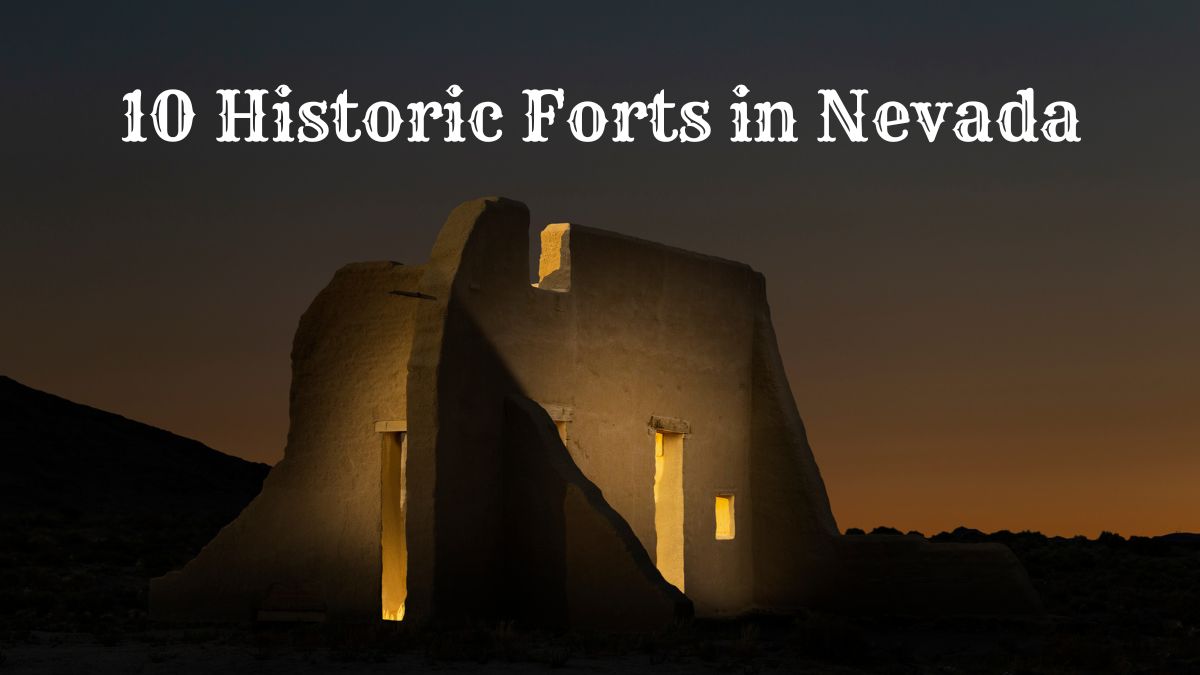Nevada, often synonymous with its glittering entertainment epicenter, Las Vegas, has layers of history that go far beyond the neon lights and slot machines. Beneath the vast desert landscapes and the silhouette of the Sierra Nevada mountains lies a tapestry of stories waiting to be uncovered.
Integral to this rich tapestry is the historic forts of Nevada—silent sentinels that have withstood the test of time.
These forts, born from necessity and strategic significance, shaped the state’s destiny and told tales of brave pioneers, native tribes, and the relentless spirit of the Old West. Journey with us as we step back in time and explore the stone, wood, and tales of Nevada’s historic forts.
Historic Forts in Nevada
| 1. Fort Churchill | 6. Old Las Vegas Mormon Fort |
| 2. Fort Halleck | 7. Camp McGarry |
| 3. Fort McDermit | 8. Fort Ruby |
| 4. Buckland Station | 9. Williams Station |
| 5. Fort Mojave | 10. Camp Sadler |
1. Fort Churchill
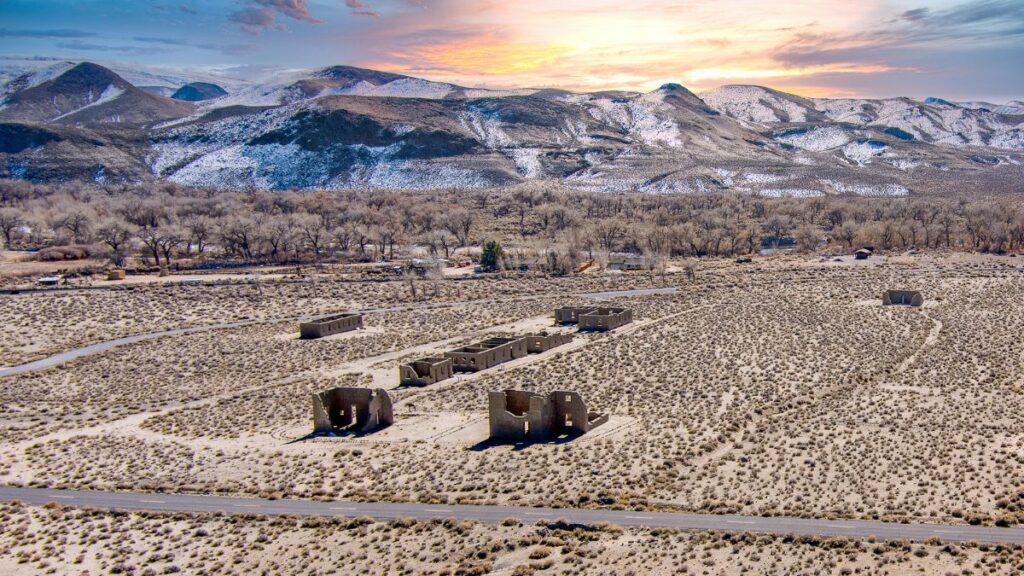
Located in Silver Springs, Nevada, Fort Churchill serves as a poignant reminder of the early days of the American westward movement. Built in 1861, its establishment directly responded to the Pyramid Lake War, a confrontation between the U.S. and the local Native American Paiute tribes.
This conflict arose from tensions between the settlers and the Paiutes, driven mainly by early European settlers’ mistreatment of the indigenous population.
Captain Joseph Stewart and his Carson River Expedition played a significant role in the fort’s establishment. Recognizing the region’s strategic importance, Stewart and his men constructed Fort Churchill as a military post to safeguard settlers, the Overland Route, and its vital telegraph lines.
Pyramid Lake War (1860)
Before the fort’s construction, this was the seminal event that underscored the need for a protective military presence in the region. The war was ignited when Paiute warriors, led by Chief Numaga, retaliated against a series of injustices by early settlers and clashed with Major William Ormsby’s volunteer forces.
Protection of the Pony Express (1860s)
Fort Churchill was a base to safeguard the vital Pony Express mail route, ensuring messages could traverse the dangerous terrains between Missouri and California.
Establishment of the Overland Telegraph
The 1860s marked a transformative era in American history, not least because of the technological leap that the telegraph represented. Before its widespread use, messages would take weeks, if not months, to traverse the vast American landscape. With the telegraph’s inception, this time was reduced to mere minutes.
The telegraph’s rapid communication was nothing short of revolutionary, facilitating everything from business transactions to rapid responses to emergent situations on the frontier.
The telegraph’s reliable functioning was paramount in the vast expanses of the American West, where distances were great and threats from both man and nature were ever-present. Enter Fort Churchill.
Situated strategically along the Overland Route, Fort Churchill became an essential protector of these vital communication lifelines.
With their poles and wires exposed, the telegraph lines were vulnerable to environmental factors and potential sabotage. Keeping them operational meant safeguarding the nation’s ability to maintain unity, order, and progress during rapid expansion and frequent conflict.
At Fort Churchill, soldiers were tasked with patrolling and overseeing stretches of the telegraph lines.
Their presence deterred potential attackers, be they dissenting Native American tribes who saw the creeping infrastructure as a further encroachment on their lands or others who might have sought to disrupt this new form of communication for personal or political reasons.
The End of an Era
However, as time progressed and threats in the region diminished, the necessity for such a fortified presence waned. By 1869, the transcontinental railroad’s completion further diminished the fort’s significance, as the new transport system bypassed it entirely. By 1871, the fort was deemed obsolete and was abandoned by the U.S. Army.
Today, Fort Churchill State Historic Park commemorates this once-important fort of Nevada.
2. Fort Halleck
Once found in the expansive landscapes of Nevada, close to the modern town of Elko, stands the historical marker of Fort Halleck. The fort’s location was no accident; it was strategically placed to oversee and protect two critical arteries of westward expansion: the Central Pacific Railroad and the California Trail.
Shielding the Central Pacific Railroad
The 1860s was a time of unprecedented growth and change for the United States, with the Central Pacific Railroad playing a vital role in that transformation. As tracks were laid across the vast expanse of the West, connecting isolated communities and facilitating commerce, they also became potential targets.
The railroad represented not just a mode of transport but a symbol of the burgeoning industrial age and the federal government’s reach and influence.
Fort Halleck’s troops ensured the safety of this vital infrastructure. Patrols would traverse alongside the tracks, keeping a vigilant eye for potential threats and ensuring that construction crews could work without fear of attack.
Safeguarding the California Trail
Before the railroad was the California Trail—a major emigrant trail spanned over 3,000 miles, guiding thousands of hopeful settlers and gold seekers toward the West’s promises.
While it offered the hope of a new beginning, the journey was dangerous. Native American tribes, seeing the ever-increasing flow of settlers as a threat to their way of life and sovereignty over their lands, sometimes staged raids against these wagon trains.
Fort Halleck stood as a beacon of safety for these travelers. Its presence provided a semblance of security, offering a place of respite and a deterrent against potential raids. The fort’s soldiers often escort vulnerable wagon trains through treacherous stretches, ensuring their safe passage.
A Testament to the Tensions of Expansion
Fort Halleck’s establishment and primary roles underscore the broader tensions and challenges of the 1860s. As the U.S. expanded and sought to bind its vast territories with rails and roads, it also grappled with the consequences of encroaching upon lands home to Native American tribes for centuries.
3. Fort McDermit
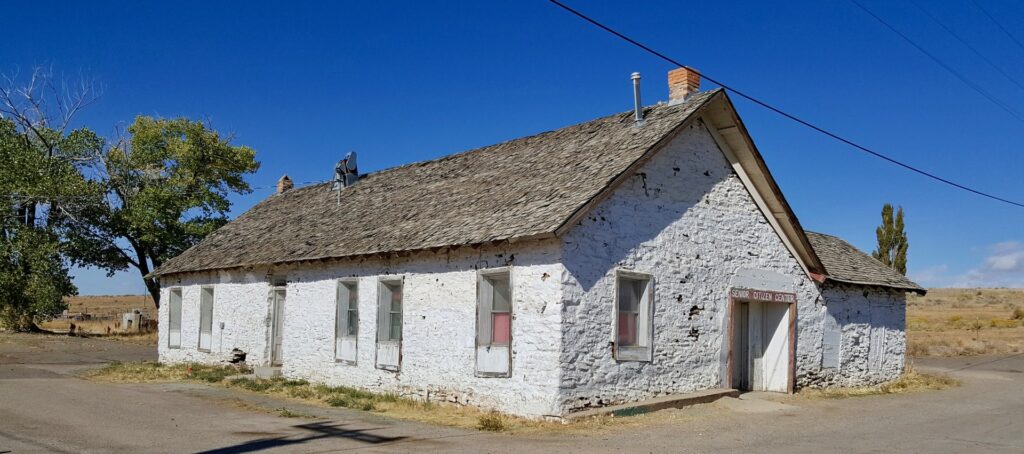
Situated near the nexus of the Nevada-Oregon border, Fort McDermit occupied a unique position in the tapestry of American westward expansion.
Its locale wasn’t just a matter of geographical coincidence; it was a calculated decision to ensure the safety of settlers moving through this frontier territory, where the boundaries of two states met, and myriad cultural and economic exchanges took place.
Guarding Against Native American Threats
The 1860s were a time of uneasy tensions between early American settlers and Native American tribes. As settlers pushed westward, seeking land, opportunity, and manifest destiny, they invariably encroached upon territories home to indigenous peoples for generations.
This encroachment, coupled with the settlers’ often dismissive or exploitative interactions with Native American tribes, led to heightened tensions and frequent confrontations.
In this volatile backdrop, Fort McDermit served as a bulwark of protection. The fort was more than just a physical stone and timber structure; it symbolized the U.S. government’s commitment to safeguard its citizens as they ventured into new territories.
The soldiers there patrolled the surrounding areas, deterred potential tribal raids, and often acted as intermediaries in conflicts, attempting to broker peace when possible.
A Haven for Settlers
Beyond its military role, Fort McDermit became a beacon of hope and safety for the settlers. For those who had undertaken the perilous journey west, the sight of the fort’s walls often signified a brief respite from the relentless uncertainties of frontier life.
Within its confines, settlers could find shelter, trade, receive medical aid, and gather information about the trails and territories ahead.
Legacy of Fort McDermit
Today, Fort McDermit is a poignant reminder of the complex dynamics of the 1860s American West. It bears witness to the challenges of expansion, the intricacies of cultural interactions, and the lengths to which a young nation went to ensure the safety and prosperity of its people.
Through its history, we glimpse the struggles, sacrifices, and enduring spirit of those who shaped the destiny of the American frontier.
4. Buckland Station
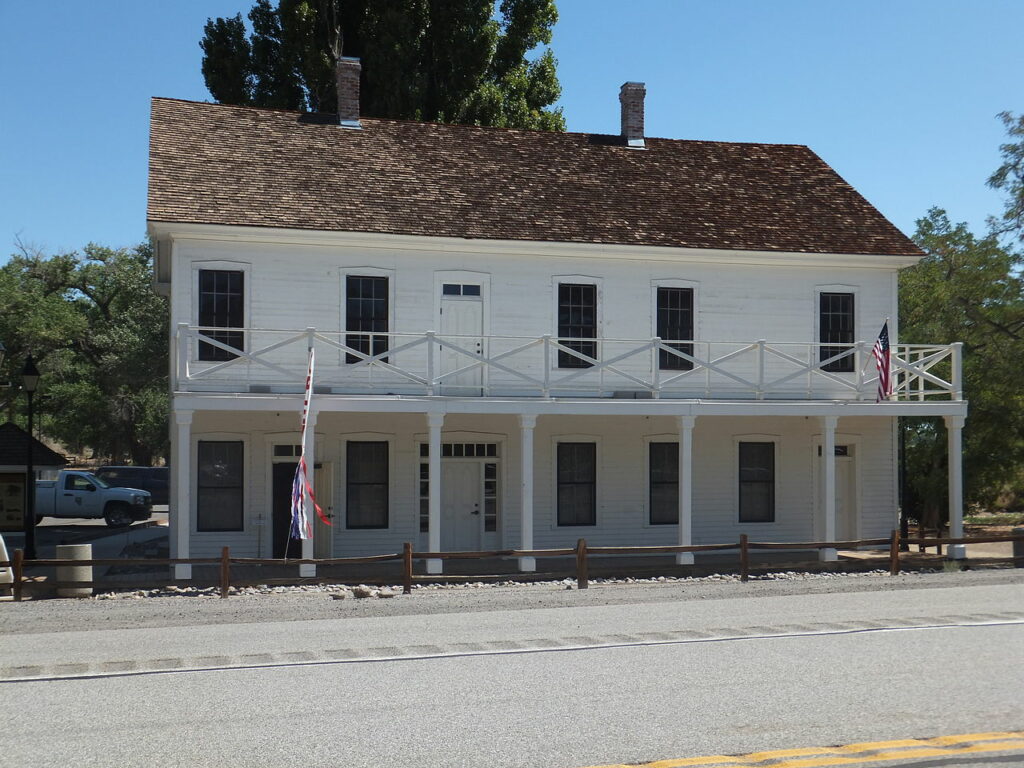
Buckland Station often existed in its shadow, located near the more well-known Fort Churchill. Yet, while it didn’t boast the imposing fortifications of its military counterpart, Buckland Station had its unique role etched into the annals of Western expansion.
Its geographical position was instrumental in the service it provided to two of the most critical communication lines of its time.
Supporting the Pony Express Riders
The Pony Express, despite its relatively short operational history, became legendary for its riders’ daring feats, who braved extreme conditions to deliver mail across vast distances.
At intervals along this challenging route, riders required places of rest, resupply, and sometimes urgent assistance. Buckland Station emerged as one such essential waypoint. Whether offering a fresh horse, a hot meal, or just a momentary shelter from the harsh elements, the station ensured that the mail got through, rain, shine, or snow.
Anchor for the Overland Telegraph
The Overland Telegraph was another marvel of its time, shrinking the communication gap between the coasts. However, maintaining this extensive network wasn’t without its challenges. Breaks in the line, from natural wear and tear or deliberate sabotage, needed quick repairs to ensure uninterrupted communication.
The station, positioned along the telegraph route, provided a base for repair crews, offering them much-needed logistical support. Its presence ensured that any disruptions could be swiftly addressed, keeping the young nation connected.
More Than Just a Station
While not fortified like a traditional military base, Buckland Station’s significance wasn’t less. It was a hub of activity, a melting pot where travelers from diverse backgrounds converged. It bore witness to countless stories of hope, adventure, despair, and determination, each traveler leaving behind a part of their tale.
5. Fort Mojave
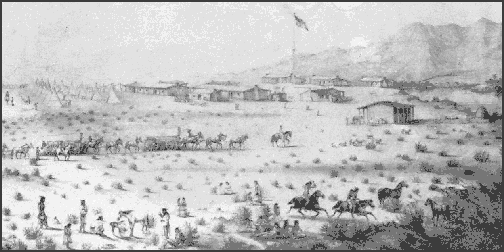
Straddling the fluid boundaries of what is today Arizona, California, and Nevada, Fort Mojave stands as a unique embodiment of the interconnected history of these states.
Its strategic location, overlooking the Colorado River and vital trade routes, positioned it at the nexus of cultural, economic, and military influences in the Southwest during the mid-19th century.
Origins and Establishment
As the 1850s dawned and America’s hunger for westward expansion grew, the need for fortified points to protect settlers and safeguard communication routes became evident. Fort Mojave, established in this decade, was one such outpost designed to exert federal control over a vast, diverse, and often challenging terrain.
The Mojave War: A Clash of Cultures
One of the most defining chapters in Fort Mojave’s history is its role in the Mojave War. The Mojave tribe, after whom the fort was named, had for centuries inhabited the areas around the Colorado River.
The tribe’s interactions with the new wave of American settlers and gold seekers were initially peaceful. However, as more settlers traversed their lands—often disrespecting native customs and resources—tensions escalated.
The straw that broke the camel’s back was a series of confrontations and misunderstandings, culminating in open conflict between the U.S. military and the Mojave tribe. Fort Mojave became a pivotal point in this struggle, serving as a base for U.S. operations and a deterrent against further tribal resistance.
Beyond the Battlefield
While its role in the Mojave War is undeniably central to its historical significance, Fort Mojave was more than just a military installation.
Over the years, it facilitated trade, supported exploration and surveying missions, and acted as a bridge between diverse cultures—Native American tribes, Mexican traders, and American settlers.
Fort Mojave’s Enduring Legacy
Today, as we reflect upon the storied past of Fort Mojave, we’re reminded of the complexities of the American frontier’s history.
The fort symbolizes the conflicts that shaped the Southwest and the potential for understanding and collaboration across cultures. Its remnants, spread across three states, offer a tangible link to a time when the boundaries of nations and states were still being defined, and the destinies of diverse peoples were irrevocably intertwined.
6. Old Las Vegas Mormon Fort

Long before the neon lights and bustling casinos that have come to define Las Vegas, the arid valley played host to a very different kind of establishment: the Las Vegas Mormon Fort.
Located at a natural spring in what would become one of the world’s most iconic cities, this fort’s history is intertwined with faith, ambition, and the quest for a better life in the western frontier.
Mormon Missionaries in the West
The 1850s was a decade of movement and change for The Church of Jesus Christ of Latter-day Saints, commonly known as the Mormon Church. Seeking refuge from persecution and driven by a sense of divine purpose, Mormon pioneers journeyed westward, establishing settlements and spreading their faith.
Within this context, missionaries ventured into the Las Vegas Valley, laying the foundation for the Las Vegas Mormon Fort.
Their objective was twofold: to convert Native Americans to their faith and to establish a waypoint for others traveling between Salt Lake City and California. Given its location near a freshwater spring in an otherwise parched landscape, the site was ideal for such a settlement.
A Nexus of Commerce and Faith
Though its primary purpose was religious, the fort quickly became a hub of commerce and trade. The freshwater spring attracted travelers and traders alike, and the fort’s strategic location made it a natural stopping point.
Over time, the fort’s walls bore witness to countless exchanges, both commercial and cultural, as diverse groups intersected in this desert oasis.
Preservation and Legacy
While the fort’s active use by the Mormon community was relatively short-lived, its significance to the region’s history was undeniable. Recognizing this, efforts were made to preserve the fort’s remnants.
Today, the Old Las Vegas Mormon State Historic Park is a testament to the city’s origins, offering visitors a glimpse into a Las Vegas before the glitz and glamour.
From Modest Beginnings to Modern Metropolis
The Las Vegas Mormon Fort is a poignant reminder of the city’s humble beginnings. While Las Vegas has since evolved into a global entertainment capital, the fort symbolizes the determination, faith, and vision of those early settlers who saw potential in a desert spring.
Their legacy continues to shape the city, reminding us that even amidst the bright lights, the echoes of the past are ever-present.
7. Camp McGarry
Nestled to the north of what is now known as Winnemucca, Camp McGarry emerged as a beacon of hope and safety in the vast landscapes of northern Nevada. Its strategic location was not a mere coincidence; instead, it was deliberately positioned to oversee and protect the primary arteries of westward movement during the turbulent 1860s.
The Turmoil of the 1860s
The decade of the 1860s was marked by profound change and volatility across the United States. As settlers increasingly ventured westward in search of land, prosperity, and new beginnings, they often found themselves traversing territories that were unfamiliar and fraught with potential dangers.
Whether from challenging terrains, unpredictable weather, or potential confrontations with Native American tribes, the journey west was not for the faint of heart.
Guardian of the Routes
Amid these challenges, Camp McGarry stood firm. Its establishment was an apparent response to the need for protection along major travel routes.
Settlers, traders, and other travelers could find solace in knowing that as they approached this part of their journey, a haven existed where they could seek shelter, assistance, or simply a brief respite before continuing their trek.
The soldiers stationed at Camp McGarry carried the weighty responsibility of ensuring the safety of these transient visitors. Regular patrols and reconnaissance missions ensured the nearby trails were safe from potential threats and that travelers could proceed with a semblance of security.
A Symbol of Federal Commitment
Camp McGarry wasn’t merely a physical establishment of wood and stone. It embodied the U.S. government’s commitment to fostering westward expansion and ensuring that those who embarked on the perilous journey westward did so under the protective wing of the federal authority.
Legacy of Camp McGarry
Today, while the bustling activities of the 1860s have long subsided, the legacy of Camp McGarry endures. It stands as a testament to the challenges faced by those early settlers and the infrastructural response that arose to support them.
It’s a poignant reminder of the intricate dance between exploration and safety, ambition and responsibility, and the indomitable spirit of those who dared to venture into the unknown.
8. Fort Ruby
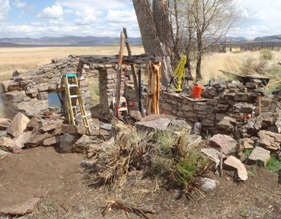
During one of the most turbulent periods in American history, 1862 witnessed the establishment of Fort Ruby. As the Civil War raged, maintaining clear and safe communication lines between the Western states and territories became paramount.
Situated as a crucial link between California and Union forces in Utah, Fort Ruby was entrusted with safeguarding these vital connections.
Braving the Desert’s Extremes
Beyond the looming threat of Confederate interception or sabotage, the very environment in which Fort Ruby was situated posed its formidable challenges.
The high desert’s vast expanse, characterized by searing days and freezing nights, tested the mettle of every soldier stationed there. Water scarcity, unpredictable weather shifts, and isolation from significant settlements meant that life at Fort Ruby demanded resilience, adaptability, and a fair share of grit.
Strategic Importance and Decline
The fort’s significance was determined by its geographic location and the era’s broader geopolitical context. With the Civil War casting shadows of uncertainty over the nation’s future, outposts like Fort Ruby were vital in ensuring that the Union’s western front remained secure and cohesive.
However, as the war concluded and the nation embarked on a path of reconciliation and reconstruction, the urgency that once underscored Fort Ruby’s role began to diminish.
By 1869, with communication lines more secure and the immediate threats of the war era no longer looming large, the fort was deemed surplus to requirements and was subsequently abandoned.
Echoes of the Past
Today, as one traverses the landscapes where Fort Ruby once stood tall, the visible remnants might be scant, but the historical weight is palpable. The relics of stone and timber are more than just physical remnants; they are silent witnesses to an era of conflict, sacrifice, and determination.
Fort Ruby in Collective Memory
While the walls of Fort Ruby no longer resound with the footsteps of soldiers or the clatter of Morse code transmissions, its legacy endures. It serves as a poignant reminder of the lengths to which a nation went to preserve its unity, the challenges faced on the home front, and the ever-evolving dynamics of geopolitical strategy.
9. Williams Station
In the heart of present-day Churchill County, Williams Station wasn’t just another waypoint on the map. It embodied the spirit of westward expansion that characterized the 19th century.
Established by the enterprising James R. Williams, this station became an integral part of the journey of countless pioneers seeking new horizons.
The Multi-Faceted Role of Williams Station
Williams Station was more than a mere resting spot; it was a multifunctional hub catering to diverse needs. As a mail station, it ensured that letters from families, loved ones, and businesses reached their intended recipients across the vast expanse of the United States.
This communication link connected the newly expanding western territories with the more established eastern states.
Equipped as a campground, Williams Station provided weary travelers a place to rejuvenate and recuperate. Here, pioneers could share stories, exchange advice, and forge bonds, turning the vast wilderness into a community, even if just for a night.
But perhaps its most crucial role was that of a trading post. At a time when resources were scarce and every commodity valuable, the station became a bustling marketplace. Travelers could exchange goods, buy essential supplies, and even gather intel about the trail ahead, helping them prepare for the challenges they might face.
A Catalyst for Nevada’s Growth
Williams Station’s strategic position along the Oregon Trail made it indispensable. It wasn’t just a pitstop but a critical juncture that enabled the flow of goods, people, and information.
The station directly contributed to Nevada’s economic and cultural growth by facilitating this movement. As more people passed through and interacted with this hub, it played a silent yet profound role in molding the character and identity of the region.
10. Camp Sadler
Amid the rugged landscapes of Nevada, Camp Sadler emerged as a shelter against the elements and a strategic bulwark during the tumultuous times of the Civil War. As the nation grappled with division, Nevada was at the crossroads of conflict and politics.
Sustenance Amidst Strife
Camp Sadler was more than just a military outpost; it was a lifeline. The camp became an indispensable logistical hub, providing lodging and essential supplies for Confederate troops.
In a region where resources were sparse and the environment harsh, the provisioning role of Camp Sadler was vital. It ensured that soldiers, far from their home bases, had the resources to maintain their campaigns.
Confederate Ambitions in the West
The Confederate forces had a clear agenda in establishing their presence in Nevada: they aimed to solidify their hold over the region and ensure the integrity of their supply lines. Camp Sadler’s strategic location allowed it to serve as a launching pad for such endeavors, effectively anchoring Confederate aspirations in the American West.
Shaping Nevada’s Civil War Legacy
Nevada’s Civil War history is a tapestry of complex allegiances, strategic movements, and regional politics. In this intricate mosaic, Camp Sadler stands out as a defining thread.
The camp and other fortifications shaped Nevada’s participation in the war, determining its allegiances and influencing its post-war trajectory.
Echoes of the Past
While the guns of the Civil War have long fallen silent, the significance of Camp Sadler in Nevada’s history remains. Today, it serves as a reminder of the state’s role in a more significant national conflict, and of the challenges and sacrifices faced by those stationed far from the primary theaters of war.
Camp Sadler in Collective Memory
The stories of Camp Sadler are more than just historical accounts; they are testimonies to the resilience of troops, the strategic importance of the American West during the Civil War, and the ever-changing tapestry of national unity.
For those who seek to understand Nevada’s place in this pivotal chapter of American history, Camp Sadler stands as a beacon of insight and reflection.
Related: Historic Forts in North Dakota
Significance of Forts to Nevada’s Early Settlers
Historic forts in Nevada played a crucial role in the lives of early settlers, providing necessary support and protection against harsh conditions and potential threats.
One example is the Old Fort, which functioned as a supply depot for individuals and families moving throughout the American West.
The founder of the Old Fort, Samuel Buckland, was an early settler who recognized the need for a way station to cater to the needs of travelers.
Under his guidance, the fort became essential in assisting the American West’s development and expansion. As a result, this fortress, among other historic sites, preserved the community’s connection and paved the way for more permanent settlements.
Another vital element linking the forts to early settlers is their military significance. For instance, during the Pyramid Lake War, these forts helped protect settlers from potential violence. The region’s forts often served as strategic locations, offering shelter and supplies during conflict.
Samuel’s wife, Eliza Buckland, was crucial in supporting the fort and the early settlers. She provided essential services such as cooking, medical aid, and shelter. Her contributions exemplify the community spirit and cooperation critical to the success and growth of early Nevada communities.
Related: 10 Historic Forts in Pennsylvania
Transportation and Communication in Historic Nevada
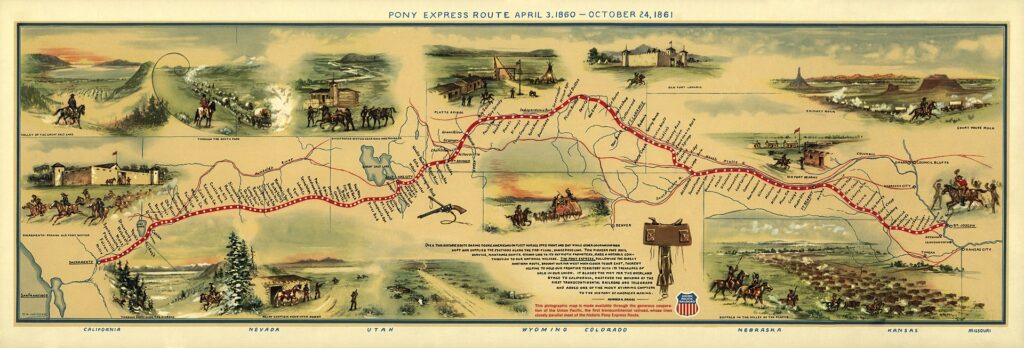
Once a thriving hub for transportation and communication during the 19th century, Nevada had a rich and compelling history. With key locations such as Carson City and significant travel routes such as the California Trail, many travelers and settlers passed through in search of opportunities and new horizons.
The Swift Riders of the Pony Express
One of the most iconic transportation systems in Nevada was the Pony Express. Established in 1860, it provided a vital link between Missouri and California, allowing faster communication between the East and West coasts.
The Pony Express crossed through Nevada, with stations about every 10 miles. Riders traveled on horseback, swiftly carrying mail over long distances.
The Central Overland Route: A Path to Prosperity
Another important route was the Central Overland Route, also known as the Wagon Road. This passage connected Salt Lake City to Carson City and western California.
Many migrants, drawn by the prospect of gold and silver, followed this route to popular destinations such as Virginia City and Silver Springs. These settlements experienced rapid population growth and economic booms due to mining activities.
Rapid Communications: Telegraph Lines Span the Continent
At the same time, the construction of telegraph lines significantly improved communication in the region.
The first transcontinental telegraph, completed in 1861, connected the Western Union network in the Eastern United States with the new settlements in Nevada and California. As a result, information could travel across the continent in mere hours, instead of weeks by mail.
Preserving Nevada’s Historic Landmarks
Establishing the National Park Service provided valuable guidance and protection for these historical sites, preserving the legacy of Nevada’s transportation and communication systems. Today, many historic trails, including the California Trail, can still be experienced through leisurely hikes or horseback riding.
Reflections on Nevada’s Pioneering Spirit
The transportation and communication infrastructure in historic Nevada played a crucial role in shaping the state’s development and growth during the 19th century. The remnants of these systems serve as a testament to the determination, resilience, and ingenuity of the people who contributed to Nevada’s rich history.
Related: 10 Historic Forts in Oklahoma
Forts and the Resource Exploitation
In the early days of Nevada, forts played an essential role in the region’s development, particularly in resource exploitation.
The gold rush, fur trade, and resource-rich areas along the Colorado and Carson rivers all needed defensive structures and strategic outposts.
Fort Laramie: A Hub in the Fur Trade Era
One prominent example is Fort Laramie, established during the fur trade’s peak. This fort was a critical hub for trappers and traders seeking to navigate the lucrative fur trade market. It also provided a base for Kit Carson, a renowned frontiersman, and explorer.
Guardians of Gold: Fortifications during the Gold Rush
the gold rush progressed, and forts became essential in establishing control over resource-rich areas. This was especially true around the Colorado River, where the discovery of gold and other valuable minerals attracted thousands of fortune seekers.
Forts near the river provided a way for regulatory authorities to maintain order and control access to the valuable resources in the region.
Carson River Ranches: Thriving Amidst Natural Wealth
By the early 1930s, Carson River ranches were prospering due to their location within a resource-rich area. The strategic placement of forts along the Carson River allowed for the effective exploitation of resources while protecting the settlers and their interests.
It also ensured the continued prosperity of the ranches, which relied heavily on the resources found along the riverbanks.
Related: 10 Historic Forts in Vermont
Connection with the Native Americans
Forts in Nevada played a significant role in the interactions between the local Native Americans, particularly the Paiute tribe, and the settlers who ventured into the region.
As California-bound emigrants began to traverse Nevada, the forts became essential hubs for these travelers.
Trading Posts: Exchanging Goods and Wisdom
Many forts, such as Fort Hall, served as trading posts where Native Americans and emigrants could exchange goods and information.
Local Paiutes had long established a presence in the area, and their familiarity with the land proved invaluable to settlers who sought guidance to navigate the arid landscape. The Paiutes demonstrated their expertise by assisting travelers in acquiring essential resources, such as water and food, and offering help on the best routes.
Cultural Exchange and Mutual Growth
In return, California-bound emigrants shared their cultural and technological advancements with the local Native Americans. This exchange facilitated the growth of mutually beneficial relationships that allowed both groups to coexist and thrive in the region.
However, tensions occasionally arose between the two communities when resources were scarce, or disagreements over land claims emerged. Park rangers and local ranchers helped mediate such tensions and maintain harmony between the Native Americans and the settlers.
They were crucial in establishing and enforcing shared protocols for managing resources, such as grazing rights and water access.
Legacy of Interactions: Shaping Nevada’s Future
Nevada’s historic forts thus served as focal points for building relationships between Native Americans and settlers. The interactions at these forts impacted the area’s cultures, economic systems, and environment, and provided a foundation for the diverse community in Nevada today.

Cory is a website owner and content creator who enjoys fishing, history, coin collecting, and sports, among other hobbies. He is a husband and father of four.
Romans 15:4 For whatever was written in former days was written for our instruction, that through endurance and through the encouragement of the Scriptures we might have hope.

